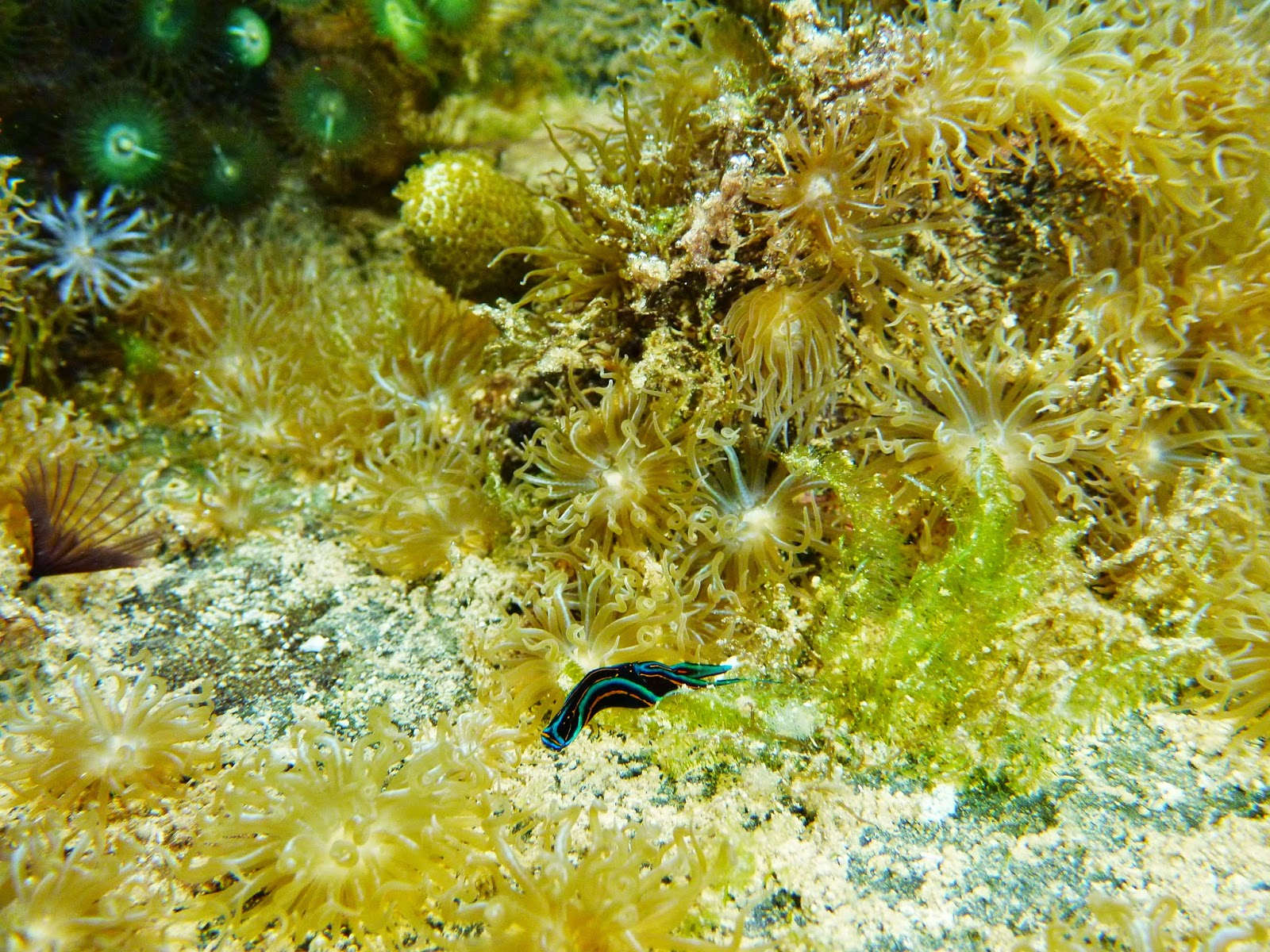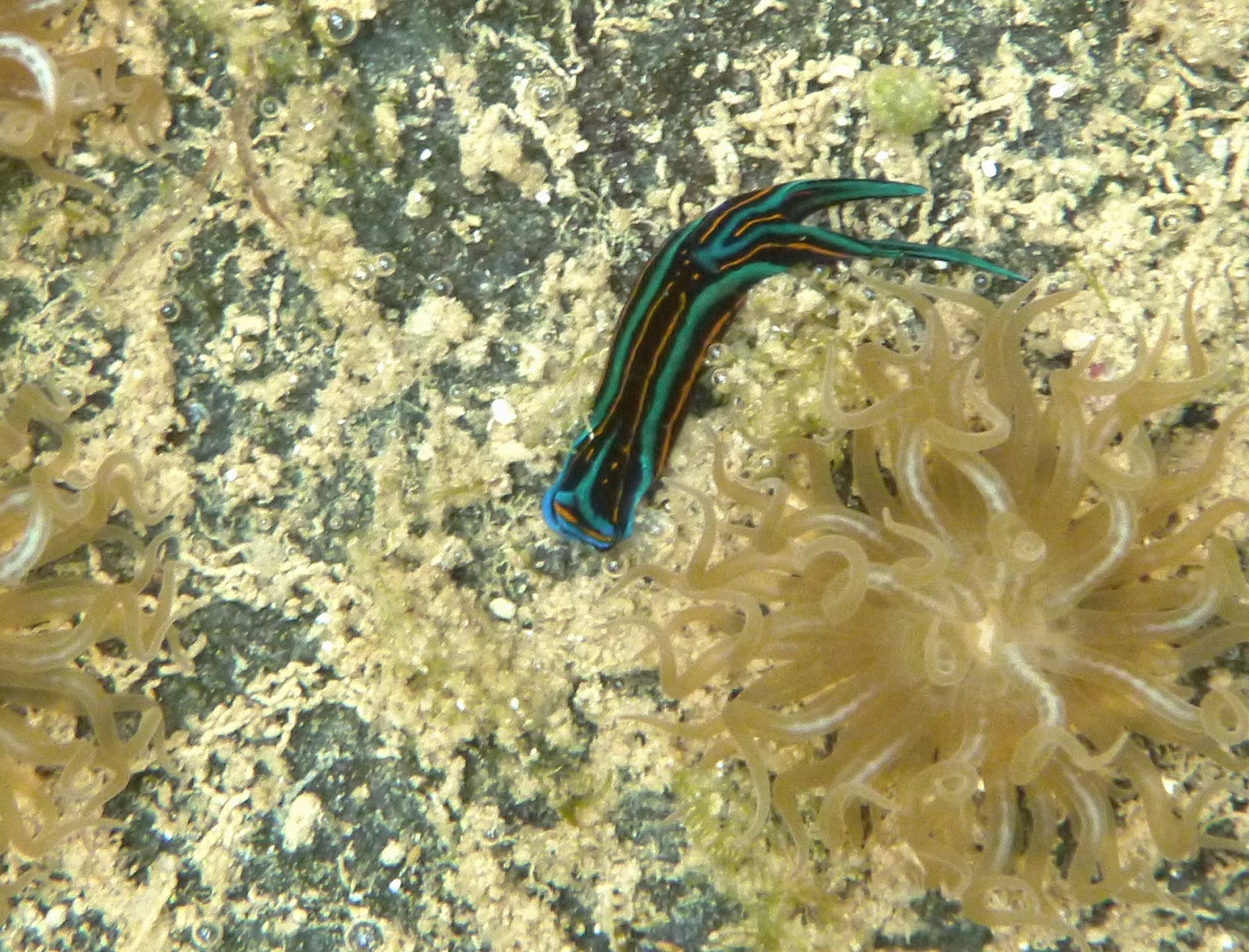 | |
|
Another new inhabitant I noticed was the lined sea hare, Stylocheilus striatus (Quoy & Gaimard, 1832), whose prevalence coincides with the appearance of patches of Lyngbya algae floating around the Bay during the second half of summer.
The last of the new inhabitants was the blue swallowtail slug, Chelidonura hirundinina (Quoy & Gaimard 1832), which almost went unnoticed, despite its dramatic coloration of pitch black, offset by lines of bright neon blue, green and orange. These tiny slugs are known flatworm predators. As in my previous observations of the blue swallowtail slugs, there were two individuals present. Which is good, because this is the minimum number necessary for sperm trading!
"What?!" you say?
Like most sea slugs, the blue swallowtail slugs are hermaphrodites, possessing both male and female reproductive organs. During mating, each slug is simultaneously playing the role of male and female, both giving and receiving. The ocean is a very big place and it isn't easy for these less common animals to find a partner. So, when they do encounter another slug of the same species, possessing both female and male anatomy tremendously increases the likelihood of successful mating and egg-laying.
Even among slugs, there is a level of behavioral recriprocation during the act of reproduction. In the article titled, "Gender Trading in a Hermaphrodite," researchers ran an experiment to see if mating behavior would change if one of the partners was basically neutered and could not fully reciprocate in the mating process by giving sperm. They found that, although these slugs will normally copulate multiple times in row, a slug which doesn't inseminate its partner will soon be abandoned. After all, it isn't sperm trading if only one slug goes away "pregnant."
It gets more interesting. What if a slug's partner does produce sperm for trade, but isn't "father" material? Since the receiving slug has invested a lot of energy creating its own eggs and sperm, instead of ejecting a partner's "useless" sperm, the recipient ingests it, presumably recouping some of its energetic losses. Not a great trade, but better than nothing.
The next time you are walking by the No Touch Tables, lift the cover and take a close look. You might find something new and unexpected.
Leon Weaver
Sources:
Anthes, Nils, Annika Putz, and Nico Michiels. "Gender Trading in a Hermaphrodite." Current Biology. Cell Press, 11 Oct. 2005. Web. 14 Aug. 2014..
Mating Behaviour of the Sperm Trading Sea Slug Chelidonura hirundinina: Repeated Sex Role Alternation Balances Reciprocity: http://onlinelibrary.wiley.com/doi/10.1111/j.1439-0310.2007.01440.x/abstract?deniedAccessCustomisedMessage=&userIsAuthenticated=false
The last of the new inhabitants was the blue swallowtail slug, Chelidonura hirundinina (Quoy & Gaimard 1832), which almost went unnoticed, despite its dramatic coloration of pitch black, offset by lines of bright neon blue, green and orange. These tiny slugs are known flatworm predators. As in my previous observations of the blue swallowtail slugs, there were two individuals present. Which is good, because this is the minimum number necessary for sperm trading!
 |
| Chelidonura hirundinina. image by L. Weaver |
Like most sea slugs, the blue swallowtail slugs are hermaphrodites, possessing both male and female reproductive organs. During mating, each slug is simultaneously playing the role of male and female, both giving and receiving. The ocean is a very big place and it isn't easy for these less common animals to find a partner. So, when they do encounter another slug of the same species, possessing both female and male anatomy tremendously increases the likelihood of successful mating and egg-laying.
Even among slugs, there is a level of behavioral recriprocation during the act of reproduction. In the article titled, "Gender Trading in a Hermaphrodite," researchers ran an experiment to see if mating behavior would change if one of the partners was basically neutered and could not fully reciprocate in the mating process by giving sperm. They found that, although these slugs will normally copulate multiple times in row, a slug which doesn't inseminate its partner will soon be abandoned. After all, it isn't sperm trading if only one slug goes away "pregnant."
 | |
|
The next time you are walking by the No Touch Tables, lift the cover and take a close look. You might find something new and unexpected.
Leon Weaver
Sources:
Anthes, Nils, Annika Putz, and Nico Michiels. "Gender Trading in a Hermaphrodite." Current Biology. Cell Press, 11 Oct. 2005. Web. 14 Aug. 2014.
Mating Behaviour of the Sperm Trading Sea Slug Chelidonura hirundinina: Repeated Sex Role Alternation Balances Reciprocity: http://onlinelibrary.wiley.com/doi/10.1111/j.1439-0310.2007.01440.x/abstract?deniedAccessCustomisedMessage=&userIsAuthenticated=false


No comments:
Post a Comment